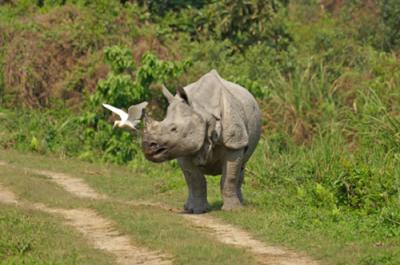|
The park is about 32 kms from Tezpur and 140 kms from Guwahati. The Park is famous for its natural scenic beauty that snatches the attention of the visitors / tourists to it. The park has a chequered history of habitation. Up to 1900, it was inhabited by the local tribes. On account of an epidemic disease, the tribal population abandoned the area. However, in 1915 the British declared it as Orang Game Reserve vide notice No. 2276/R dated May 31, 1915. The game reserve came under the control of the wild life wing of the State Forest Department to meet the requirements of the Project Tiger. It was established as a wild life sanctuary in 1985, vide notification No. FRS 133/85/5 dated September 20, 1985. But in 1992, the park was renamed as Rajiv Gandhi Wildlife Sanctuary but this action had to be reversed due to public pressure against the renaming. Finally, the sanctuary was declared as National Park in 1999 vide notification No. FRW/28/90/154 April 8, 1999.
Orang park contains significant breeding populations of several mammalian species. Apart from the Great Indian One-Horned Rhinoceros (68 nos at the last count), which is the dominant species of the national park, the other key species sharing the habitat are the Royal Bengal Tiger (Panthera tigris tigris), Asiatic elephant, Pygmy Hog, hog deer and wild boar. Some important species of the critically endangered and endangered category are the following.
Pygmy Hog, a small wild pig, is Critically Endangered, C2a(ii) ver 3.1 as per IUCN listing, and is limited to about 75 animals in captivity, confined to a very few locations in and around north-western Assam, including the Orang National Park where it has been introduced.[9] Other mammals reported are the Blind Gangetic Dolphin, Indian Pangolin, Hog Deer (Axis porcinus), Rhesus Macaque, Bengal Porcupine, Indian Fox, Small Indian Civet, Otter, Leopard cat {Prionailurus bengalensis), Fishing cat (Felis viverrina) and Jungle Cat (Felis chaus).
The Royal Bengal Tiger (Panthera tigris tigris), categorized as Endangered on the IUCN Red List (IUCN, 2008), has an estimated population of about 19 (data source:Forest Department of Assam; census year 2000, based on pug marks) in the park.
The Great Indian One-Horned Rhinoceras (Rhinoceros unicornis) even though well conserved now in many national parks and in captivity, is still in the endangered list of IUCN and its population is estimated at 68, as per census carried out by the forest department, in 2006.
More than 50 species of fish have been recorded in the river and channels flowing through the park.
The park is home to a variety of migratory birds, water birds, predators, scavengers and game birds. 47 families of Anatidae, Accipitridae, Addenda and Ardeiae are found in the park with maximum number of species. 222 species of birds have so far been recorded, some of which are: Spot-billed Pelican (Pelicanus philippensis), Great White Pelican, Black-necked Stork (Ephippiorhynchus asiaticus), Greater Adjutant Stork (Leptoptilos dubius), Lesser Adjutant Stork (Leptoptilos javanicus), Ruddy Shelduck (Tadorna ferruginea), Gadwall (Anas strepera), Brahminy Duck, Mallard (Anas platyrhynchos), Pintail (Anas acuta), Hornbills, Pallas's Fishing Eagle (Haliaeetus leucoryphus), King Fisher and Woodpecker, in addition to forest and grassland birds. But Bengal Florican (Houbaropsis bengalensis), which is in the threatened list of IUCN is one of the flagship species in the park with a population 30-40 (recorded second highest concentration as per Bombay Natural History Society (BNHS)) and is in the threatened list of IUCN.[3][4][8][10] Migratory birds as far as from America such as the milky American White Pelicans have also been reported in the park.
Among reptiles, seven species of Turtle and Tortoise are found, out of which turtle varieties such as Lissemys punctata, Kachuga tecta are common. Among snakes, pythons [disambiguation needed] and cobras are recorded here. Indian Rock Python, Black Krait, King Cobra, Cobra, Monitor Lizard are the reptiles found here.
How To Reach Orang National Park:
By Air : The nearest airport is Saloni, 10km from Tezpur (32km from the park) in Sonitpur district. However Guwahati has better connections with almost all the major cities to India and it is around 140-km from Guwahati
Railhead : The nearest railhead is Saloni (41km) & Rangapara. Both Tezpur and Guwahati are connected very well by the rail network of India.
Road Transport : Regular buses ply to and from Tezpur, which is well connected with all the major cities of Assam. Orang can be approached from NH 52 through gravel roads running from Orang town and Dhansirimukh. The sanctuary is 15 km off the national highway near Orang town (Dhansirimukh).
Where to stay in Orang National Park:
The park has only a small rest house. There are better accommodation at Tezpur from where one can visit this park. Assam Orang National Park offers two resthouses and one dormitory facility for visitors. For more deails of tezpur click here
Park Safari Timings:
Visitors can enter the area only in the mornings or afternoon preferably on elephant back.
Best Time To Visit Orang National Park:
October to April is the best season to visit the park. However, advance authorization of the Divisional Forest Officer, Mangaldoi is essential to visit the park. |







